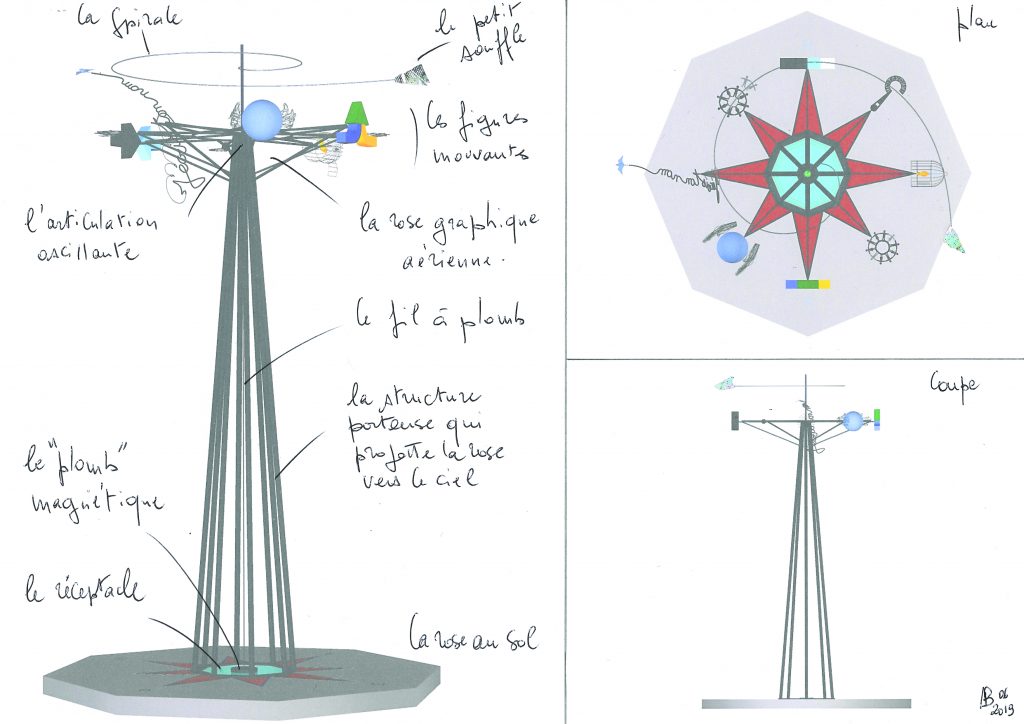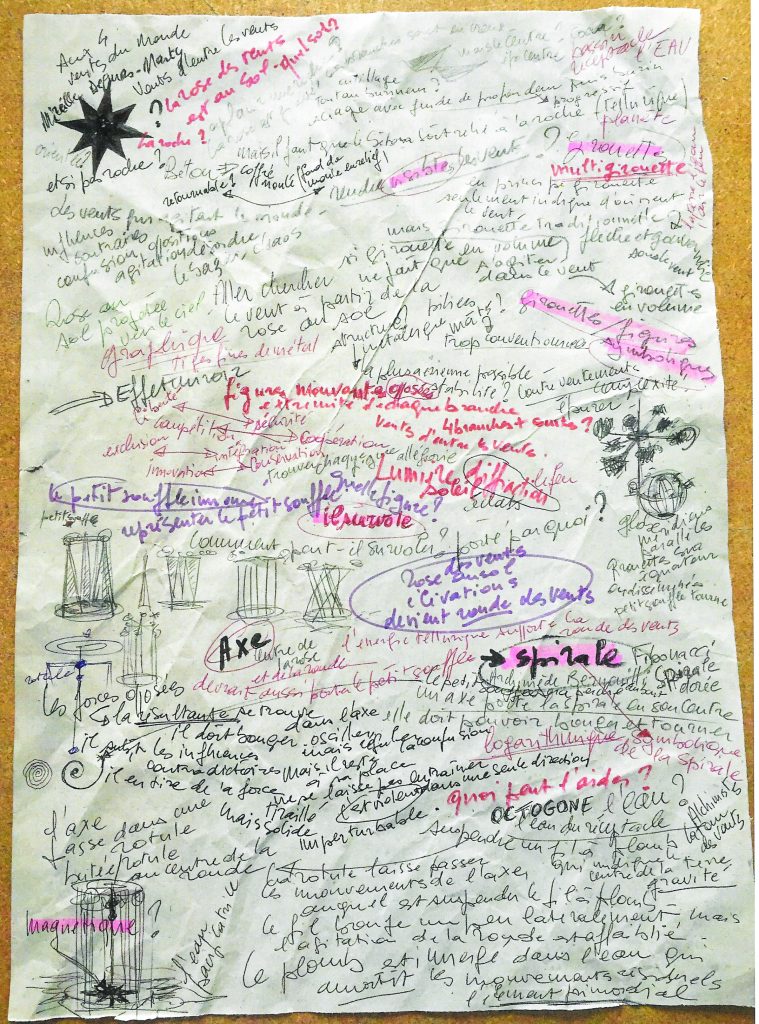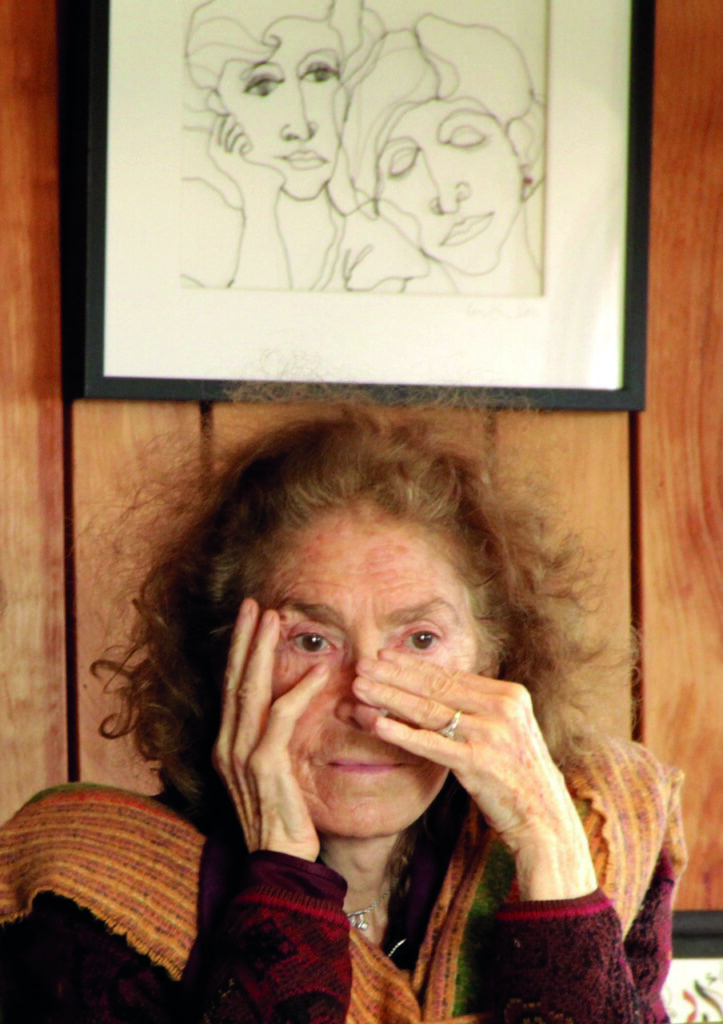EPILOGUE
Of compasses, crossings, law and poetry. To Mireille, imaginative force of law
by Emanuela Fronza
“Mireille Delmas-Marty. Quelle grande et belle conscience qui s’en va”. This is Edgar Morin’s tweet on 12 February 2022, the day Mireille Delmas-Marty left us.
It is not easy to continue without her, following the scattered traces she has gifted us. The translation into English of her latest book – she knew about the project and was enthusiastic about it – is one of the initiatives that open this new phase of the journey, with Mireille, though without her1Several tributes have been paid to Mireille Delmas-Marty: among these, we can recall the Seminar on 4 July 2022 at the University Paris 1, Patnhéon Sorbonne; the 23 September at the Collège de France “Imaginons” and the 13 October 2022 at the Court of Cassation in Paris..
Allowing her thought to circulate, translating it (that is, as per the Latin etymology, “carrying it beyond” her absence), is one of the ways to continue the journey in her company.
And we also continue our journey together by making her thought available2“Qu’on la lise était le plus grand souhait de Mireille Delmas-Marty. Non par narcissisme (elle n’en avait pas une once). Mais par souci de servir: elle était simplement consciente de l’importance de son oeuvre et de son utilité pour tenter de relever les défis de notre monde présent et à venir”. Cf. Geneviève Giudicelli Delage, “Lire Mireille Delmas-Marty – Avant-propos”, Revue de Sciences Criminelles, 3, 2022, p. 497., in other languages too, to allow others to orient themselves also elsewhere, to trace a path, to explore spaces that have not yet been seen and are still unknown.
The great little book “A compass of possibilities” and the object-manifesto created with Antonio Benincà, now give body and substance to the key direction indicated by Mireille Delmas-Marty’s thought: there is no dogma, but only dynamic thinking, which knows how to go forward and how to make others go forward.
This dynamism can be perceived at a glance from the titles of her books3Among the many works by the Author, we recall here in particular: Modèles et mouvements; Le flou du droit: Du Code pénal aux droits de l’homme; Pour un droit commun., and is also marked by the choice of entrusting her most recent contribution – on the topic of “accelerated” globalization, its contradictions and transformative power – to a different language, the language of art, as well as to a moving object.
The transformative power also include law and justice since the aim is not to replace one dogma with another (economic growth with degrowth, for instance, or state sovereignty with a global state).
What is necessary instead is to renew our way of thinking through a movement that can be a mirror of complexity. A dynamic thinking that, in order to adjust to the Unpredictable, must accept to remain flexible: a tested and refined method since her first writings, one that involves all rights and addresses the law to overcome its innate rigidities. This is the only approach that can allow us to find new tools suited to the characteristics and challenges posed by globalization. It is necessary to move from the certainties of dogmatic thinking to the ability to mould ourselves into “trembling thinking”, a concept dear to Édouard Glissant, the Antillean poet from whom she drew inspiration.
Determination, rigor, the mastery of legal disciplines, courage, and, among other things, poetry and art, made Mireille Delmas-Marty much more than a jurist4This is recorded by Juliette Tricot: “Oser, comme elle le dit elle-même, enseigner un savoir qui n’existe pas encore”, in “Ouverture – Des mots pour et de Mireille”, Revue de Sciences Criminelles, Juillet-Septembre 2022, p. 503..


Figs. 3 and 4. Sketches of Antonio Benincà’s sculpture (©2019 Antonio Benincà).
Her attention to reality led her to think of the concept of “law in the making”: by stabilizing without immobilizing, she invented categories capable of adapting to the events and accompanying them. Mireille is a Maître à penser, a storyteller who narrates the world around us and offers tools capable of opening up our thinking and guiding us.
The path and method that Mireille Delmas-Marty shows us appear even more topical and valuable in a period of great upheavals such as ours. Hence the decision to translate into English this text, which was published in French, and later translated into Italian5Mireille Delmas-Marty, Una Bussola dei Possibili, edited by Emanuela Fronza and Carlo Sotis, Bologna: 1088Press, 2021..
To face the crisis, it is not enough to place humanity and its values at the center of the world, as the Universal Declaration of Human Rights attempted to do in 1948. According to Mireille Delmas-Marty, a much more complex operation is needed: identifying common principles and finding the magnetic needle that leads to a humanism, extended to the whole planet, able to stand before the Unpredictable.
A jurist and, from the very beginning, an explorer and a sailor, Mireille Delmas-Marty invited us to think about movement. “By proposing the metaphor of the clouds first, later that of the winds and finally of the compass, I had a fairly simple objective in mind: to escape the confines of a static vision of law”.
Resolutely turning her back on pessimism, her course was marked by an almost prophetic ability to foresee, even well in advance, the fundamental dynamics that we face today, such as the climate crisis and planetary boundaries, which Mireille evoked already in 1992 in what is undoubtedly one of her masterpieces, Les grands systèmes de politique criminelle, translated (also) into Chinese and Persian. Mireille Delmas-Marty, an intellectual and a visionary, was above all (and perhaps precisely for this reason) an extraordinary jurist.
Mireille Delmas-Marty reasoned by problems and not by disciplines. To grasp them and indicate solutions, she invited us to think about interactions, establishing a dialogue between the real and the imaginary, while remaining always attentive both to the practical validity of her ideas and to the suggestive power of their verbalization.

object-manifesto.
The law in the making becomes a tool for humanizing globalization, so as to contribute to the maintenance of human life, without reducing it to the survival of the human species itself.
The three verbs “to resist”, “to responsibilize”, and “to anticipate”6See the titles of the chapters 1, 2 and 3 of the present book., which also give the title to one of her famous books, are an explicit invitation to this conception. With the accelerated increase of interdependencies that irreversibly come with globalization, static concepts, such as “pillar”, “base”, “foundation” or “pyramid”, risk leading us to collapse because they are unable to rebalance all the forces, even contradictory at times, that globalization sets in motion. In the construction of buildings, as in the elaboration of laws and politics, what is too rigid ends up breaking at the slightest external movement. Flexibility is not a whim, but a requisite for the survival of the structures over time. Trying to harden globalization is an absolute contradiction. What allows us to direct the compass of possibilities in the humanist direction is the presence of common principles and values of reference.
To anticipate risk, but also the current and future needs, not out of pure intellectual exercise, but to contribute concretely to imagining the law that does not yet exist but that could exist. This purpose is possible only by reflecting on dynamics instead of on concepts, on a global scale.
The point is not to halt the expanding globalization, but to reflect, through the mirror that law is, on what its directions may be.
Hence the proposal for an unconventional compass for our disoriented world. Mireille Delmas-Marty wants to warn us against a present that requires urgent action7The desire to further awaken dynamic thinking is highlighted also by Geneviève Giudicelli Delage, “Lire Mireille Delmas-Marty – Avant-propos”, Revue de Sciences Criminelles, 3, 2022, p. 498.. Without fear and without losing hope.
In order not to be overwhelmed by the winds that blow disorderly and from opposing directions, it is necessary to prevent any of them from forcefully prevailing and it is necessary to direct the compass towards humanism and, in particular, “legal humanism”8Thus Francesco Palazzo, “Il messaggio di Mireille Delmas-Marty”, Rivista Italiana di Diritto e Procedura Penale, 2022, 1, p. 1..
Hence the importance of dynamic thinking and of taking up the challenge at all levels, after having set as starting point the interdependence that characterizes our societies.
The strength of her method also consisted in knowing how to overcome the internal and enclosed horizon of the disciplines. We need to shift the point of view: we need another “way of looking” at globalization, a new paradigm.
“Now more than ever, we need legal regulation on a global scale: we need a flexible, plural and dynamic law, unstable but stabilized by reference to the different currents of humanism or, more precisely, of humanisms, because harmony, to be acceptable to all, must be inspired by a pluralist vision”.
Only this conception allows us to “order the multiple” and perceive complexity. A savage and uniformizing globalization must be contrasted with an interdependent and supportive community, which accepts differences.
Without ever denying the present, and also through this great little book, Mireille Delmas-Marty invites jurists to commit to finding ways for a human community of destiny because, by taking up the protection of common goods, the law can become a builder of reality. All her thinking recalls the importance of being jurists of the imagination, trying to find new forms and solutions in the face of complexity and unprecedented challenges, which invoke: a new order, thus one where the proposal is not black or white, but black and white, respecting a pluralism without hegemonic claims, in terms of compatibility and not of standardization. To imagine in order to see what is invisible and to think about what seems to be unthinkable. Thus, the journey of Mireille Delmas-Marty helps us to think about the rights of future generations or about a river as rights holder9Emanuela Fronza, Carlo Sotis, “Immaginare un nuovo mondo”, in Delmas-Marty, Una Bussola dei Possibili, Appendice..

Fig. 6. Photo of Mireille Delmas-Marty (©2021 Simone Pierini).
By using universal symbols as metaphors (wind, clouds, water, fire, compass, plumb line, etc.), she established links with legal thought, thus demonstrating that law can be constantly reinvented. This is how she placed the poetry of Édouard Glissant, with his reflections on mondialité10Idea developed by the Author to bridge imperialist universalism and sovereignty (unequal globalization). It is a notion to think about “us” but also about differences. Namely, it avoids the imperialist effects of globalization and it avoids the risks of sovereignty., at the center of her work. A Tout Monde open to diversity and attentive to interdependencies.
Such poetic referencing never prevented her from perceiving and affecting reality. Indeed, this was her strength: blending, combining the moment technique à l’imagination (the technical moment with imagination).
The power of her imagination, supported by a solid and rigoros method, allowed her to win several battles and witness the implementation of the reforms she proposed.
Mireille’s imagination is fuelled by the conviction that law can only be put at the service of humanity and she put this vision into practice very early, to react to changes within society and forge new tools (as a way of example, one can think of her proposal to create a European Public Prosecutor).
Mireille Delmas-Marty combines utopia, realism and technical ability. If a problem exists, the legal imagination can solve it.
The attention to metaphors, works of art and poetry, testifies to Mireille’s extraordinary ability not only to imagine but, even more so, to lead others to imagine. To sail together, in fact, yet by bearing in mind that it takes as much rigor as imagination to allow others to sail and to continue sailing. Metaphors, models, the search for words, and the compass: these are the imaginative forces of law because they pass on know-how; and exactly as in navigation, the passing on of know-how translates into the passing on of a duty to act11Thus Carlo Sotis, “Ouverture – Des mots pour et de Mireille”, Revue de Sciences Criminelles, Juillet-Septembre 2022, p. 505..
Indeed, Mireille was not only a jurist, she is a “jurispoète”, as Antonio Benincà likes to call her.
It is important to note that she did not use imagination and wonder to escape the present. They were vital to her, the common trait to the jurist and the artist: imagining and wondering to get out of an enclosed field, but also and above all to find collective solutions so that humanity could find its own answers and, thus, not give in to the temptations of violence and hence lead us to collapse.
Mireille is a humanist, in the full sense of the term: she nurtured a form of hope for humanity, a firm renunciation of fatality, yet she was not blind in front of risks and possible dangers. She was aware of the atrocities of which humanity is capable.
The Compass of (future) possibilities is therefore a powerful example of this approach, which creates a relationship between art and law12Following the well-known model of artistic residencies, she created in 2021 the first legal residencies in Europe (Adamas Residencies)..
With the Compass of future Possibilities project – which is still ongoing13Antonio Benincà is working on a new and bigger version of the “Compass of Possibilities”. – Mireille establishes another element of her method and action: resorting to other languages to be able to intervene on globalization and turn it into mondiality (mondialité).
To express her thoughts, she relied on a language that is neither logical nor rational. “Words were no longer enough”, she said. Not only did the thought become matter, but matter fuelled legal reflection thanks to the exchange with the object-manifesto she conceived with Antonio Benincà. Reflection on universal symbols (which represent pairs of opposing winds: cooperation/competition, integration/exclusion, etc.) also led to rethinking the notions of global governance and to imagining humanism in the form of a spiral.
This is accessible to all, an idea very dear to Mireille, in line with the course she held for many years at the Collège de France (an institution that teaches research to all: without registration, without any prerequisites and without taboos).
Mireille Delmas-Marty was a tenacious sailor and a great interpreter of our time. We need to embrace, through our imagination and the law, both her warning and her invitation to recompose the landscape14Mireille Delmas-Marty insisted upon the jurist as landscape designer. by allowing the principles of justice and solidarity to guide us.
The message of this book goes far beyond the circle of jurists to address all those who care about the fate of humanity as a whole. This is the spirit of Mireille Delmas-Marty’s meditations15F. Palazzo, “Il messaggio di Mirelle Delmas-Marty per un diritto umano e planetario”, in Delmas-Marty, Una Bussola dei Possibili..
“Perhaps it will be up to this law in the making … to reconcile” so that “fear becomes solidarity in the face of risk and that responsibility does open up to hope”.
To continue sailing along the route traced by Mireille Delmas-Marty, we must look at the Compass of Possibilities and grasp the emotions and joy of this object-manifesto.



